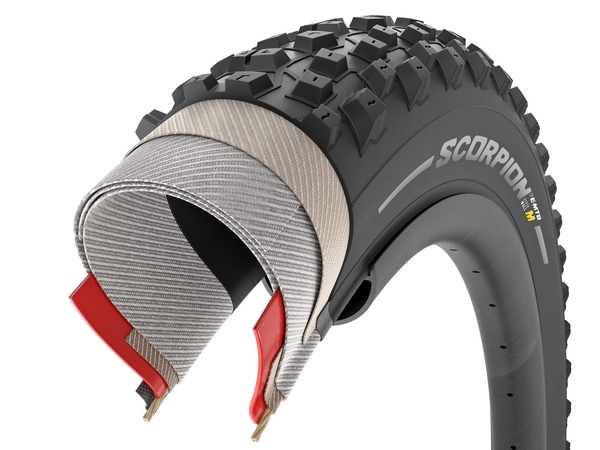Table of Contents
Tires
mountain bike, noun : An all-terrain bicycle with wide knobby tires, straight handlebars, and typically 18 to 21 gears. Webster's Dictionary, mirriam-webster.com
Fat, knobby tires define a mountain bike. They are perhaps the most important single component to a mountain bike's handling yet are often neglected, maybe because of their non-durable nature or low relative expense. So much print is spent reviewing expensive frames and components - but where are the articles or books devoted to bike tires? 1)
Schwinn was the first to promote “balloon tires” on bikes in 1933 and they proved so successful that within two years, a full 97% of all bicycles sold used Schwinn Balloon tires 2).
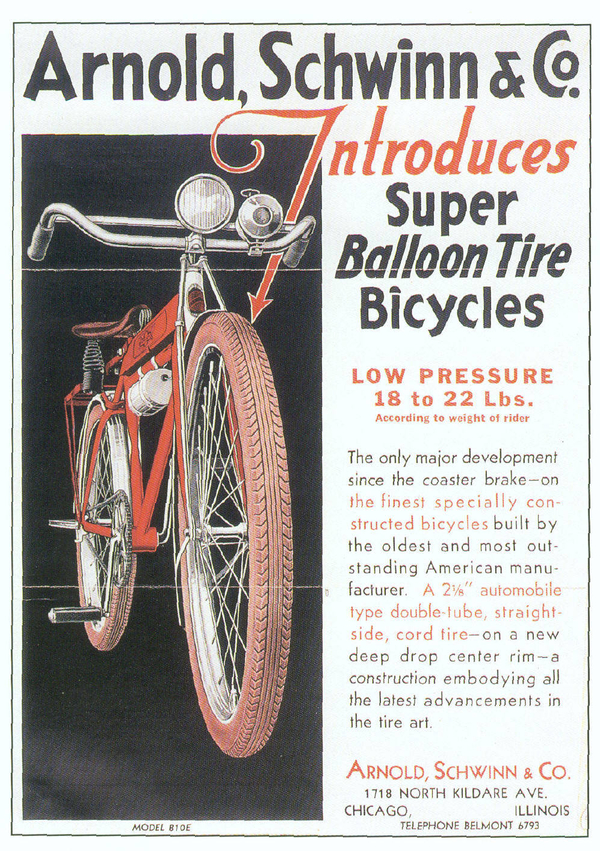
1933 Schwinn Balloon Tire, 26” x 2 1/8“
thecabe
Fast forward to Marin, 1976...
Cheap and available cruiser and BMX tires were sourced for early mountain bike and klunker tires. Their popularity pushed most early mountain bikes to be designed around 26” rims using 2 1/4“ balloon tires. The first mountain bike tires were either the Uniroyal Nobby, which weighed 1344 grams each or the nearly identical Carlisle Stud, both at 26” x 2 1/4“. In 1980, the new Cycle Pro Snakebelly dropped about a pound per tire with their light weight 26” tires and by 1981 the Mitsuboshi Skinwall, at about 896g each3) became the new standard.
Everything changed when the Snakebelly tire, the first lightweight fat tire, and the first wide aluminum rim made by Ukai became available. Now it was possible to build an awesome mountain bike! I started building CCPROTO in 1978, designing every part from the ground up for minimum weight and maximum performance4). Charlie Cunningham, from Jacqui Phelan's blog
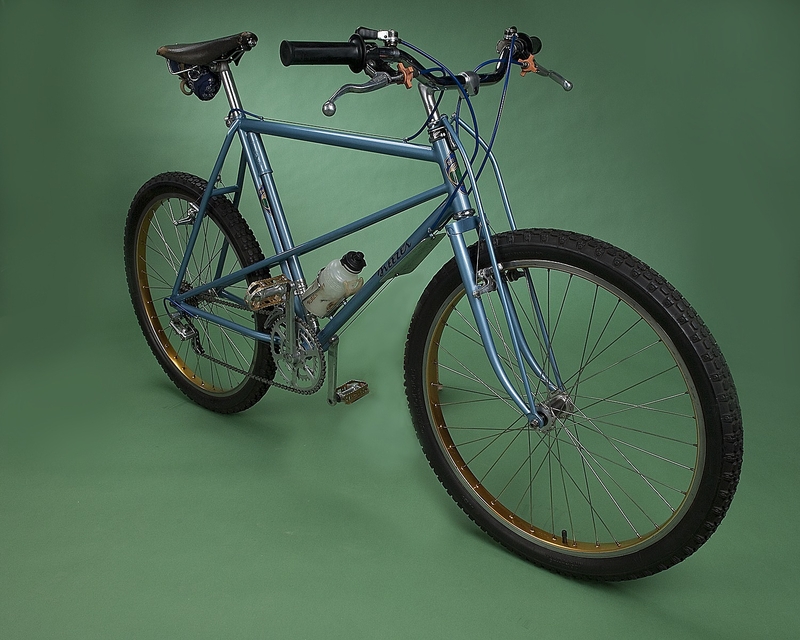
Uniroyal Nobby tires, on the 1977 Breezer JBX1
Smithsonian
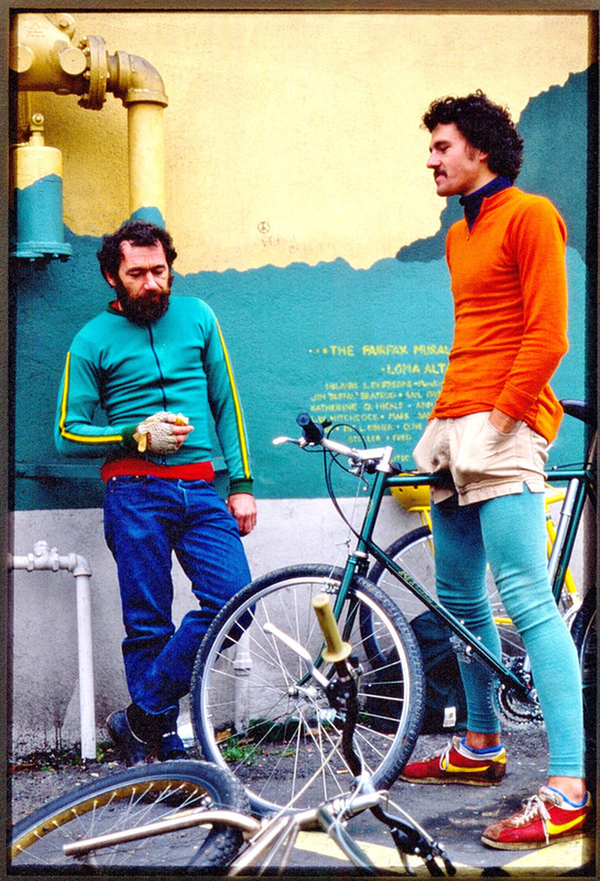
650b Nokia Hakkapeliitta tires on a 1978 Ritchey 650B
Vintage Mountain Bike Workshop
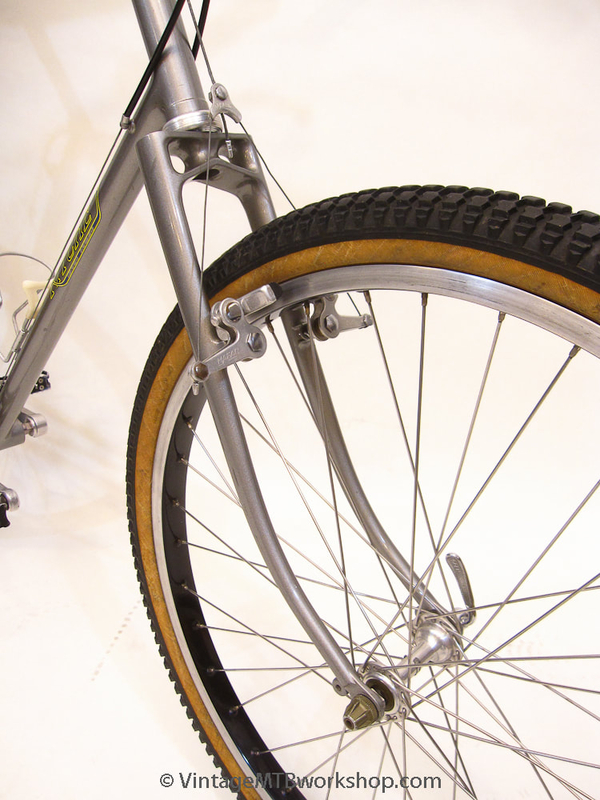
Cycle Pro Snakebelly on a 1980 Ritchey MountainBike
Vintage Mountain Bike Workshop
Tread
Width, size, tread pattern, bead material, sidewall suppleness, air pressure, puncture resistance, and tire materials all come into play making the perfect connection between dirt and bike. In the beginning, the Uniroyal Nobby was grippy enough but over heavy and could use improvement. How to make it lighter?
With mountains of bike parts and plenty of time on our hands, we messed with bikes constantly at 32 Humboldt. Someone was always building a wheel, grinding some parts, or filing or bending or hammering, all to a Bob Marley soundtrack. Since so much of the balloon-tire stuff was interchangeable, we tried all sorts of for-and-wheel-size combinations, such as a 26-inch fork and front wheel on a 24-inch frame, which I broke in half immediately.
One evening Gary [ Fisher ] used an X-ACTO knife to whittle the closely set tread on our only useful tire, the Uniroyal Nobby, into something a little more aggressive. He created an open V-tread pattern with more bite, then weighed the shavings to see how many ounces he had taken off the tire. Fat Tire Flyer, Charlie Kelly, pp. 38-39
The first mountain bike specific tire was the 1982 Specialized Stumpjumper tire, with simple knobby treads.5)
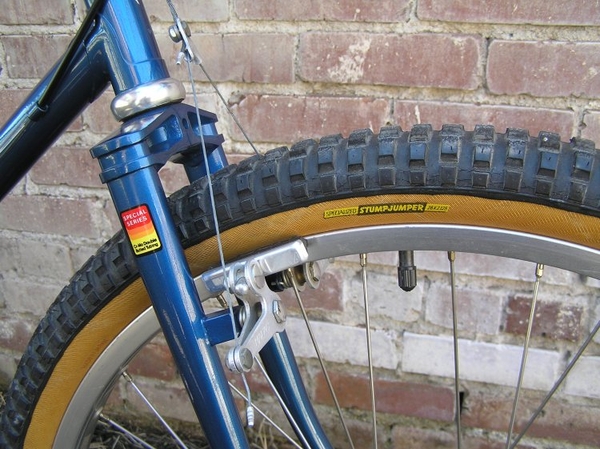
1982 Specialized Stumpjumper 26 x 2.125“. mombat
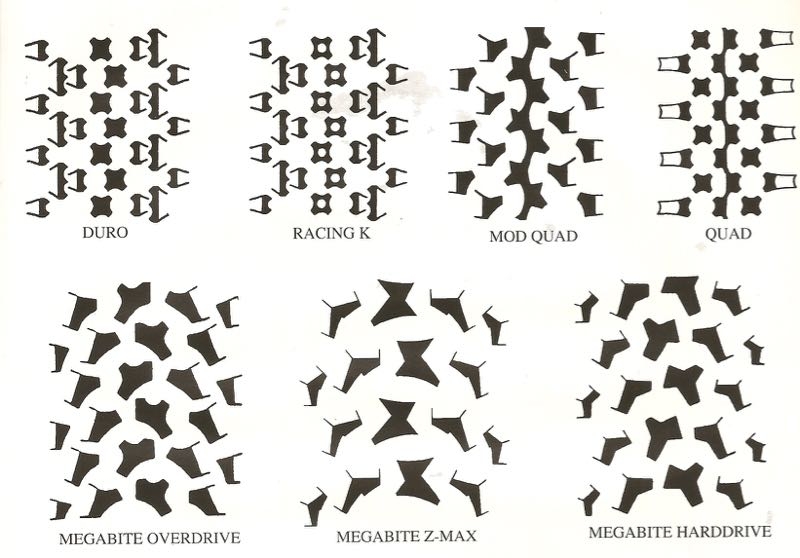
The Ritchey Family of tread patterns from 1983 (Quad) → 1991 (Megabites)6).
bikerumor
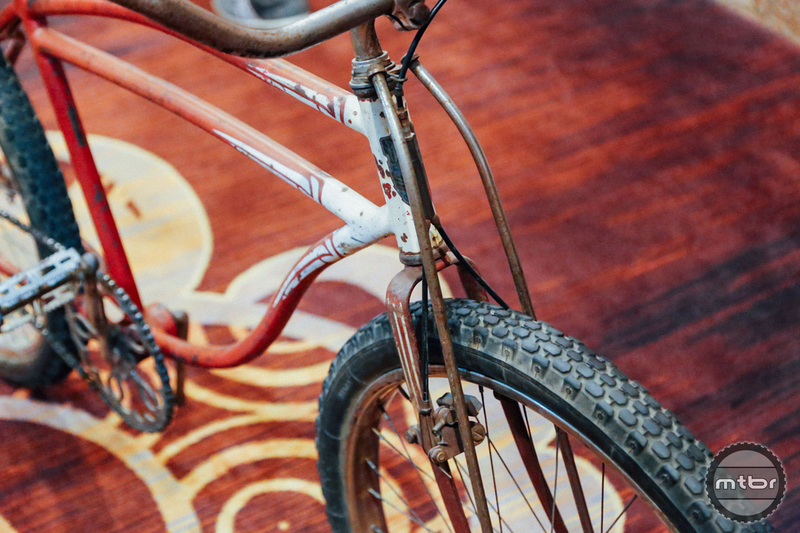
Otis Guy's Repack Racer mtbr
The first folding mountain bike tire with a Kevlar bead is the 1988 Ritchey Force Racing K, 540g, 26×1.9”.
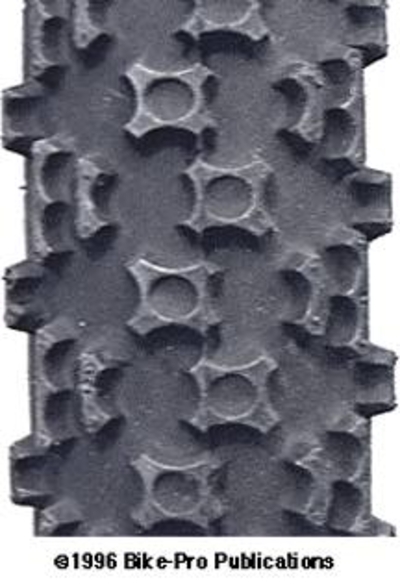
1988 Ritchey Force Racing K, 26 x 1.9“
bikepro
The first directional tire with optimized knobs is the 19887) Ritchey Megabite.
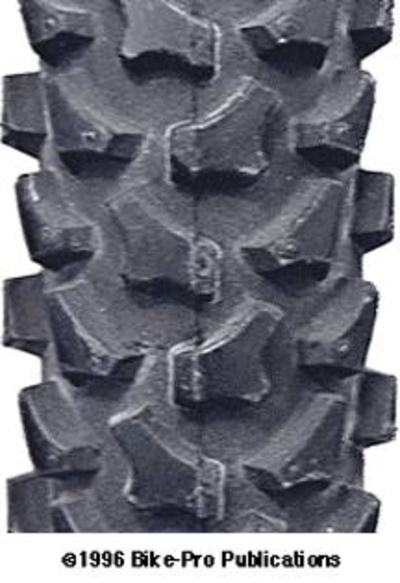
1991 Ritchey Megatbite, 690g, 27 x 2.1”
bikepro
The 29er Revolution
Today, 29ers are seen as the latest mountain bike movement. Ever since the metric system overtook English measurements for road tires in the 1970's8) “700c” tires have been the norm for road tires. Mountain bikes have stuck with the English system as Europeans never embraced 26“ balloon tires and made them metric.
Custom mountain bike builders have been producing 700c and 650b mountain bikes since the very start. A couple of early examples are 1978 Ritchey and 1979 Cleland, which used both 650b and 700c Nokian Hakkapeliitta tires. There was demand to create mountain bikes with larger tires early on, but Nokian tire production was sporadic and manufacturers were too overwhelmed to stop bike production and retool the geometries which an extra 3” in tire diameter would demand.
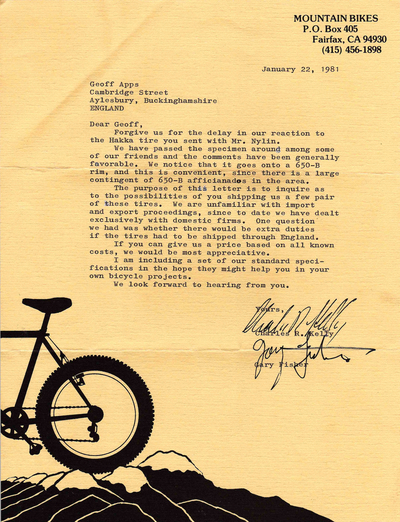
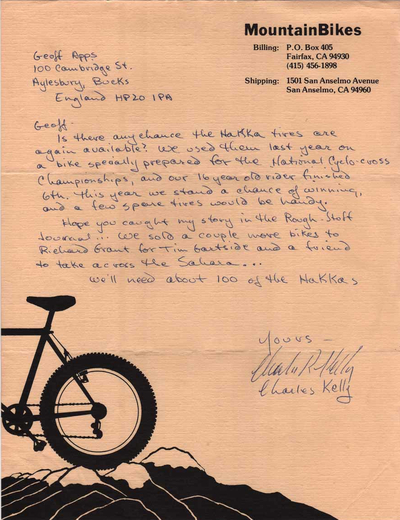
clelandcycles
Graham John Wallace, retrobike
Two letters from Charlie Kelly and Gary Fisher, circa 1981, asking for more Hakkapeliitta tires. Supposedly Geoff ended up shipping about 100 back to the states and they were installed on a few capable mountain bikes.
In 1988 Bruce Gordon introduced his Rock 'n Road All Terrain, with design help from Mert Lawwill. At 1.72“, it is more of a cyclocross tire, but it's popularity showed the demand of people wanting to take larger wheels offroad.
It's believed that the first modern 29er mountain bike tire was the 1999 Wilderness Trail Bikes Nano Raptor 29 x 2.1” tire, as shown on this prototype WTB Ti 29“. Previous 29” tires were usually less than or equal to two inches in width, which apparently don't qualify as 29ers9)
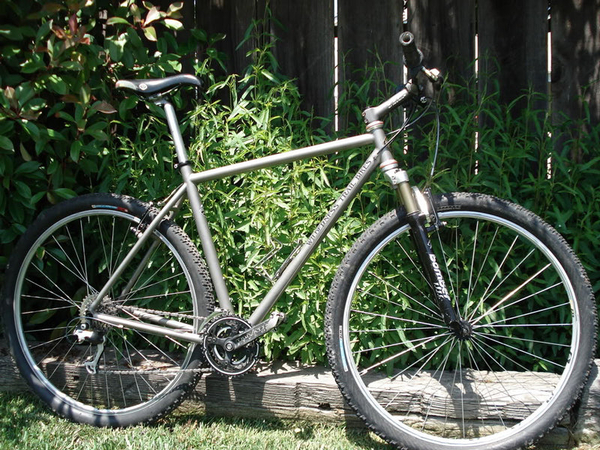
1999 WTB Ti 29” prototype for Interbike
wtb
But wait, Bianchi offered 700c mt. bikes in 1990→1994, Klein in 1992, and Diamond Back in 1993, but there never was enough market momentum behind them - and perhaps they weren't designed well10)?
Despite WTB and Bruce Gordon selling many tires (to who?) it wasn't until 2001 that mass production of a 29er bike arrived with the Gary Fisher 29er. Once again, Gary Fisher was the man with the vision of how to bring change to the world.
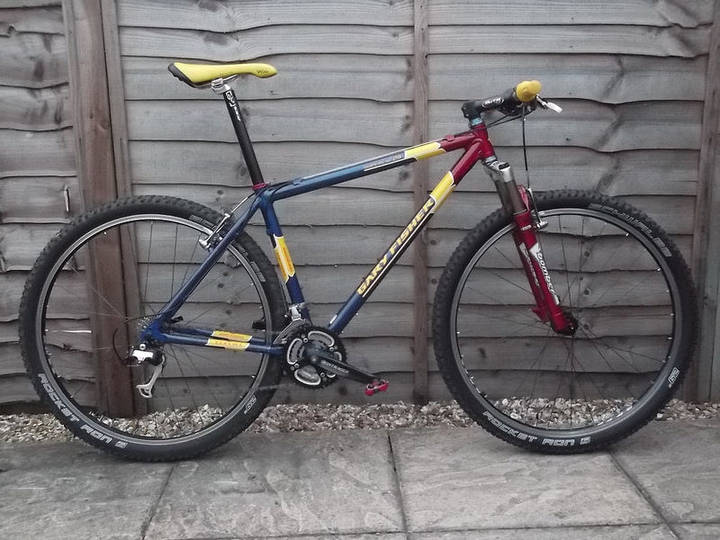
2002 Gary Fisher 29er
retrobike
First produced in 2001.
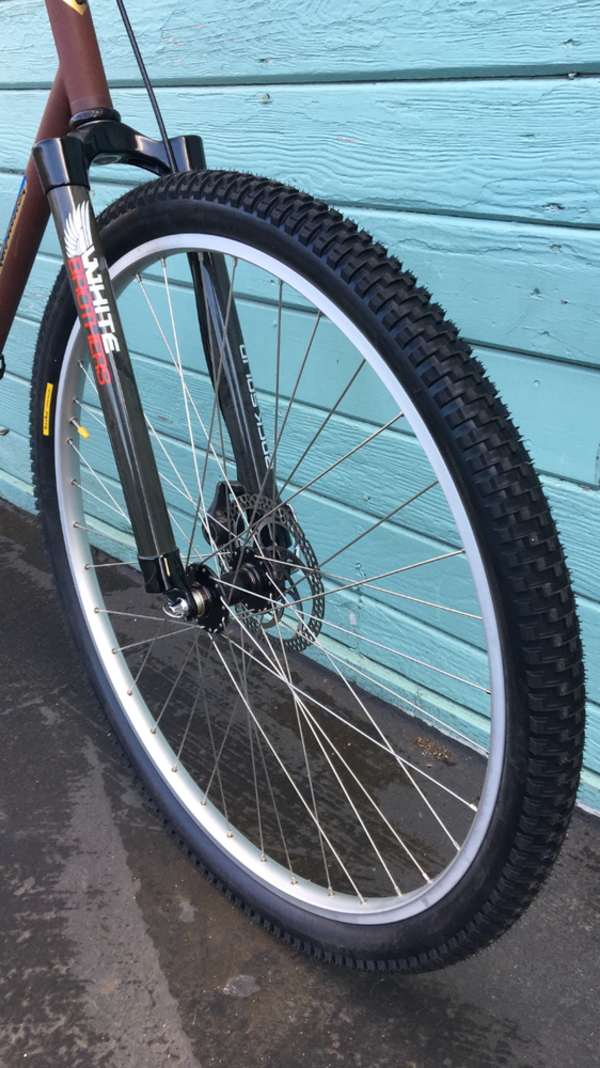
Bruce Gordon Rock 'n Road, 700c x 48mm (aka 29 x 1.9“)
First offered in 1988.
brucegordoncycles
Honor Roll
Special mention to favorite mountain bike tires over the first couple of decades.
1991 Panaracer Smoke & Dart
The Panaracer Smoke debuted in 1991 followed by the “Smoke Dart” in 1992.
The original front and rear classics. Put the Smoke on your rear wheel and feel the 3D knobs dig in going up or down for legendary grip. Put the Dart up front and experience great steering at top speeds. The gold standard of MTB tire design. Panaracer ad copy, pararacerusa.com
Today, the original tread pattern is available as “classic” editions - in 26”! See link to purchase.
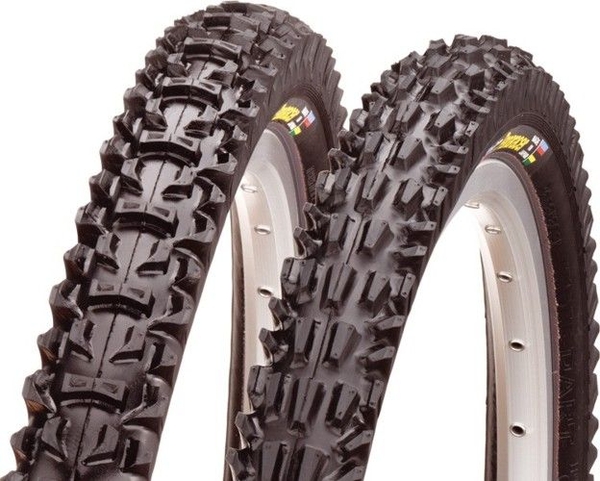
Smoke & Dart Classic ceneo
1986 Specialized Ground Control
WTB designed Specialized's family of Ground Control tires, starting in 1986 and followed later by over a dozen variants. Specialized continue to sell about eight different variants today.
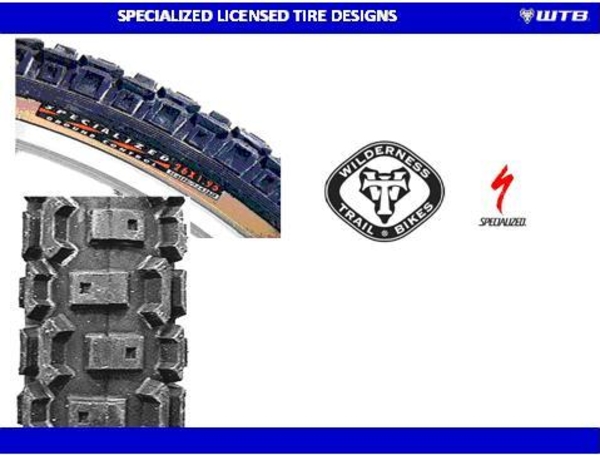
Specialized Ground Control, 26 x 1.95“
wtb
1980 Hakkapeliitta
Nokian Hakkapeliitta tires were the only early supplier of wide 650b & 700c tires good enough for mountain bikes. Built for Finland's winter 11), the Hakkapeliitta is nowadays famous for its studded tires. In 1970's & 80's they had a summer version without the studs. More info here.
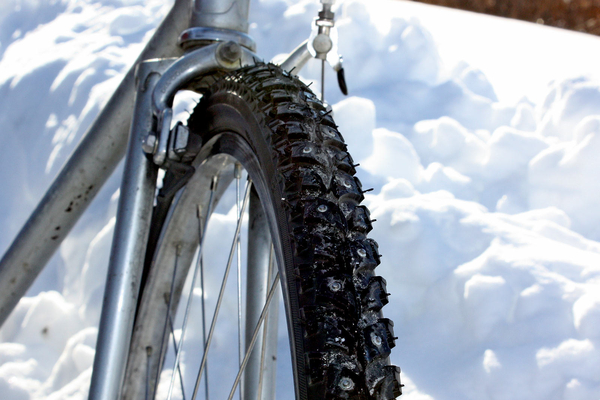
Hakkapeliitta studded tires.
flickr

